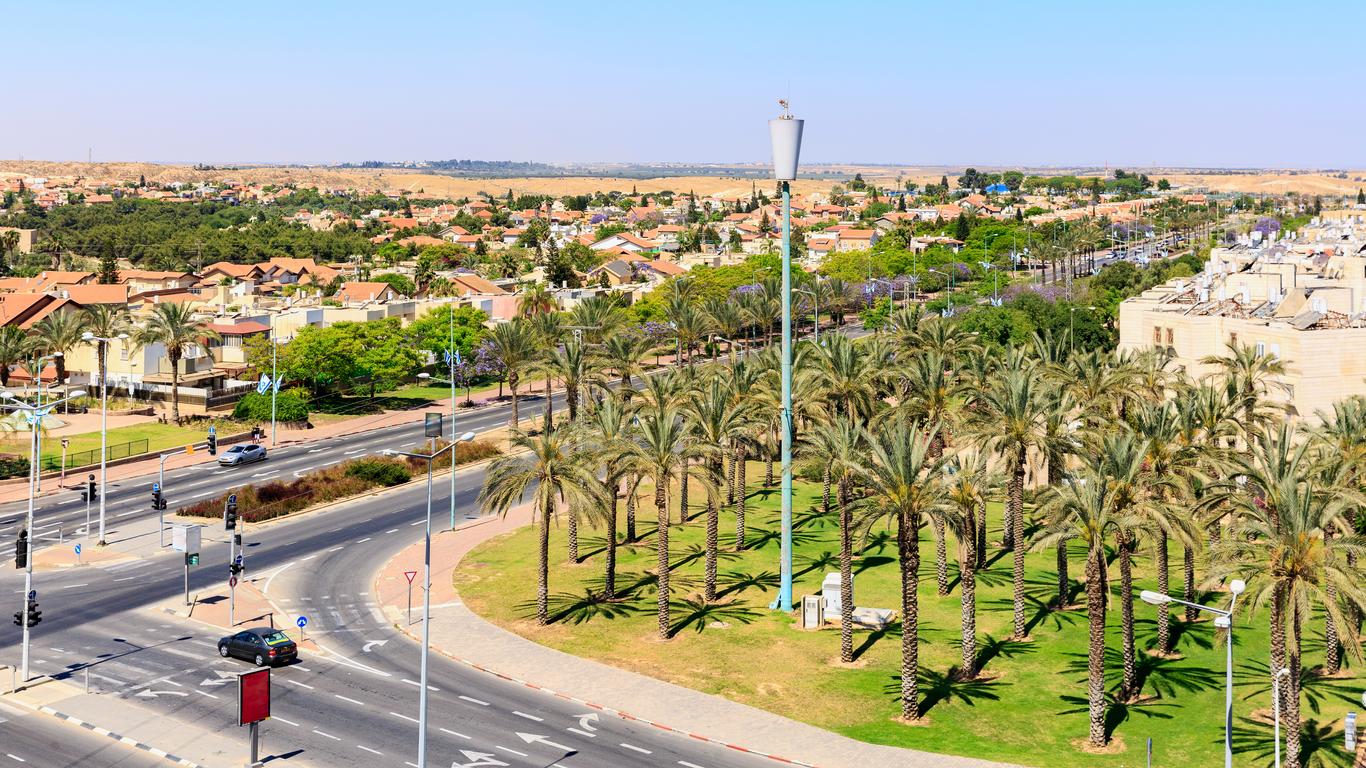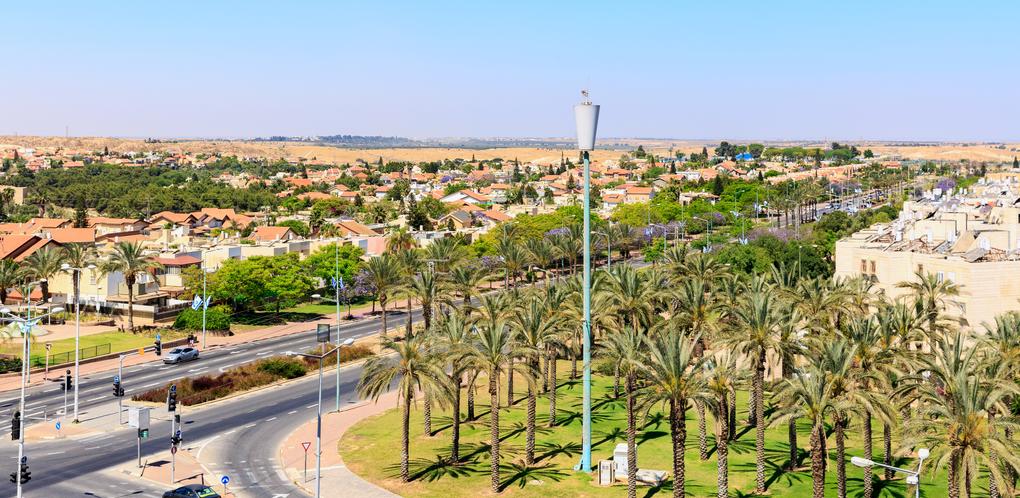
Beer Sheva travel guide
Beer Sheva Tourism | Beer Sheva Guide
You're Going to Love Beer Sheva
Beer Sheva is the perfect haven for those who want to take in all that Israel has to offer but stay "off the beaten path". There's more here than just the remains of an Ottoman Empire stronghold or significant Biblical landmarks. There's a way of life and a culture that's just waiting to be explored.

Top 5 Reasons to Visit Beer Sheva
1. Bike Around the Architecture
With its pleasant weather, historic architecture, and easy-to-navigate roadways, there's nothing better than grabbing a bike and spending the whole day cycling around.
2. Relax at Neve Midbar Beach
What's a true oasis in the desert in the modern day? Spa Neve Midbar. Make sure to book in advance and take full advantage of the romantic setting, along with the intense hot spring waters.
3. Incredible Israeli Cuisine
Because Beer Sheva is not as "crowded" as Tel Aviv or Haifa, there's a focus on local cuisine and truly authentic Israeli dishes. Eat your way through the city and skip the high prices.
4. Check Out the Nightlife
Nightlife in Beer Sheva is underground and full of students and intellectuals who like to dance as hard as anyone. Check out Baraka Club.
5. Visit the Tel Beer Sheva Archaeological Park
Declared a UNESCO World Heritage Site, this must-see spot allows visitors to witness how people lived in Biblical times.
What to do in Beer Sheva
1. Witnessing The 5Th Century In The Modern Day
Visiting the ancient ruins of the Shivta, travellers will be able to take in the hushed atmosphere that presides over the remains of a magnificent Byzantine empire. As a UNESCO designated World Heritage site, the well-preserved ruins, a fast-fading red and terra-brown, are now all that's left of the once high ceilings of the South Church. Begin here and then move to visiting the 7th century mosque, built right next to the South Church. Then, wend your way to the Council House, Middle Church, craftsmen's quarter and, finally, the North Church.
2. A Living Museum
For the story of the Israeli Air Force, you must make your way to the Hatzerim Israel Airforce Museum, a living monument to its establishment and development. While some of the largest aircraft are lined up as exhibits, others are still in commission and visitors can enjoy a take-off or two. From aircraft to helicopters, as well as a cinematic film experience that details the rich history of the Israeli aerial combat force, the range of exhibits is outdoors and visitors would do well to bring sufficient water.
3. A View Of The Craters
Another word for "mortars", Makhtesh Ramon are a set of three elliptical craters that were formed 70 million years ago. These impressive 18 mile-long craters of formidable size and depth are not of volcanic origin but rather the result of the shifting and collapsing of the land. The region of Negev is full of these craters but there is no better place to view them than from the cliffs beside Makhtesh Ramon. Once you've had your fill of the red sands and infinite abyss, head to the Makhtesh Hagadol. Reaching this requires a bit of a hike but its a sight worth seeing, especially at sunset.
4. Preserving A People
The space that is the Museum of Bedouin Culture not only reveals the history and culture of the Middle East's nomadic Bedouin tribes, it helps to preserve the ways of this people by educating visitors on their current state and place in society. Besides the various exhibits detailing their way of life, clothing, textiles, practices and language, the museum also documents the present culture of Israeli Bedouin peoples in particular. Travelers with children will enjoy the guided tours and interactive "treasure hunts" set up by the museum's staff.
5. Not Just For Kids
This interesting and unique space makes use of indoor and outdoor exhibits to bring together technology as well as the wonders of natural science. Be'er Shiva's proximity to historical sites, its predisposition for clear, desert skies and Israel's focus on science and technology as a major export make the Carasso Science Park a central hub for innovation in the Negev region. The park offers demonstrations and workshops, as well as interactive exhibits.
1. Witnessing The 5Th Century In The Modern Day
Visiting the ancient ruins of the Shivta, travellers will be able to take in the hushed atmosphere that presides over the remains of a magnificent Byzantine empire. As a UNESCO designated World Heritage site, the well-preserved ruins, a fast-fading red and terra-brown, are now all that's left of the once high ceilings of the South Church. Begin here and then move to visiting the 7th century mosque, built right next to the South Church. Then, wend your way to the Council House, Middle Church, craftsmen's quarter and, finally, the North Church.
2. A Living Museum
For the story of the Israeli Air Force, you must make your way to the Hatzerim Israel Airforce Museum, a living monument to its establishment and development. While some of the largest aircraft are lined up as exhibits, others are still in commission and visitors can enjoy a take-off or two. From aircraft to helicopters, as well as a cinematic film experience that details the rich history of the Israeli aerial combat force, the range of exhibits is outdoors and visitors would do well to bring sufficient water.
3. A View Of The Craters
Another word for "mortars", Makhtesh Ramon are a set of three elliptical craters that were formed 70 million years ago. These impressive 18 mile-long craters of formidable size and depth are not of volcanic origin but rather the result of the shifting and collapsing of the land. The region of Negev is full of these craters but there is no better place to view them than from the cliffs beside Makhtesh Ramon. Once you've had your fill of the red sands and infinite abyss, head to the Makhtesh Hagadol. Reaching this requires a bit of a hike but its a sight worth seeing, especially at sunset.
4. Preserving A People
The space that is the Museum of Bedouin Culture not only reveals the history and culture of the Middle East's nomadic Bedouin tribes, it helps to preserve the ways of this people by educating visitors on their current state and place in society. Besides the various exhibits detailing their way of life, clothing, textiles, practices and language, the museum also documents the present culture of Israeli Bedouin peoples in particular. Travelers with children will enjoy the guided tours and interactive "treasure hunts" set up by the museum's staff.
5. Not Just For Kids
This interesting and unique space makes use of indoor and outdoor exhibits to bring together technology as well as the wonders of natural science. Be'er Shiva's proximity to historical sites, its predisposition for clear, desert skies and Israel's focus on science and technology as a major export make the Carasso Science Park a central hub for innovation in the Negev region. The park offers demonstrations and workshops, as well as interactive exhibits.
Where to Eat in Beer Sheva
Head to Cafe Lola to chow down on a classic Israeli breakfast of homemade bread, smoked salmon, and fresh juice. If you come by in the evening, expect tapas-style snacks or shakes with an Israeli twist, like a blend of dates, candied pecans, and coconut milk. Two can dine for ₪65 - ₪85.
When to visit Beer Sheva
The best time to visit the region in general and Beer Sheva specifically is the winter months, from January to around March. Once April hits, the temperatures rise to 80 and keep climbing, along with the humidity.
How to Get to Beer Sheva
Plane
You'll land in Tel Aviv's Ben Gurion Airport (TLV), if you're flying internationally. From here, use the bus or train to get to Beer Sheva.
Train
To get to Beer Sheva from cities like Haifa or Tel Aviv, use Israel Railways and book online. Prices for a direct trip from Tel Aviv to Beer Sheva start at ₪30.
Car
If you're driving from Tel Aviv, use the Yitzhak Rabin Hwy/Route 6 to go south to Beer Sheva. To get from Jerusalem to Beer Sheva, start by taking Route 1 and then transfer on to Route 431, eventually getting on the Yitzhak Rabin Hwy/Route 6.
Bus
Coming in from Tel Aviv, take the 370 from Tel Aviv Central Bus Station. It costs ₪16.50. Getting in from Jerusalem, take the 470 for ₪30.
Airlines serving Beer Sheva
Where to stay in Beer Sheva
Alef - located north of the Old City, Alef is so called because it was the first neighborhood to be built after Israeli independence. It's mainly residential, with quite a few apartment blocks and townhouse rows.
Popular Neighborhoods in Beer Sheva
Gimmel - located northeast of Old City and built in the 1950s, this is where the Ben-Gurion University of the Negev is. Expect to find a large student population, lots of little eateries, and university dorms.
Old City - the unofficial downtown and the official historical center of Beer Sheva, Old City, as it's translated, is the original Ottoman conception of the stronghold of Beer Sheva. As such, it has a whole range of beautiful 19th-century buildings, is the commercial center of the city, and home to its main transportation hubs and terminals.
Where to stay in popular areas of Beer Sheva
How to Get Around Beer Sheva
Public Transportation
Beer Sheva has an informal but regular public transit bus system. It costs ₪4.30 for a one-way adult ticket and ₪200 for a monthly pass.
Taxi
Taxis in Beer Sheva can get pricey. The flat rate is ₪25 and it's ₪2.40 per mile thereafter. Expect to pay about ₪30 - ₪40 to get around.
Car
Hire a car from companies like Sixt and Budget. Daily fares vary based on provider but average ₪50 a day for a standard, 4-door compact car.
The Cost of Living in Beer Sheva
Shopping Streets
Mall-goers will love the BIG Shopping Center, which is an open-air shopping center, similar to the outlets or "power centers" in North America.
Groceries and Other
A quart of milk costs ₪5.73 in Beer Sheva and a dozen eggs will run you ₪11.62.
